There are 15 snakes in Wyoming that are native to the state, two of which are venomous. According to the Wyoming Game and Fish Department, those two species are the Prairie Rattlesnakes and the Midget Faded Rattlesnake.
According to the Animal Damage Management Board Rules in Wyoming, all snakes may be imported, except those that are listed as a dangerous species under federal laws.
While The Wyoming Game and Fish Department has little to say about snake regulations, killing the Faded Midget Rattlesnakes is illegal since they are protected by the state. However, the common Prairie Rattlesnake is easy to encounter, which is why it is perfectly legal to kill this dangerous rattler.
In most cases, you must have a permit to keep any living wildlife as a pet unless they are listed saying they are allowed without a permit.
Table of Contents
Common Snakes in Wyoming
Here are some common snakes that roam the state:
1. Yellow-bellied Racer
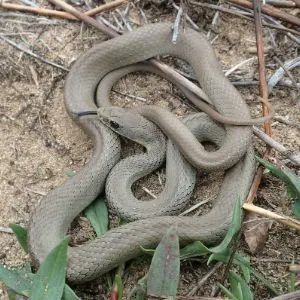
- Experience Level: Intermediate
- Family: Colubridae
- Scientific Name: Coluber constrictor mormon
- Other Names: Western Yellowbelly Racer, Western Racer
- Adult Size: 20 to 75 inches
- Lifespan: 7 to 8 years
Yellowbelly Racers usually have large eyes, a broad head with a slender neck, and a long, skinny tail. They are smooth-scaled and are typically blue-gray, brown, or olive green in color.
As you might have guessed by the name, they usually have a yellow or off-white underside.
They like a wide range of habitats like arid or moist environments including sierras, foothills, and plain woodlands.
They feed on insects, amphibians, lizards, other snakes, reptile eggs, birds, and their eggs as well. While they aren’t contractors, they will coil their prey, pinning them down before swallowing them whole.
2. Black Racer
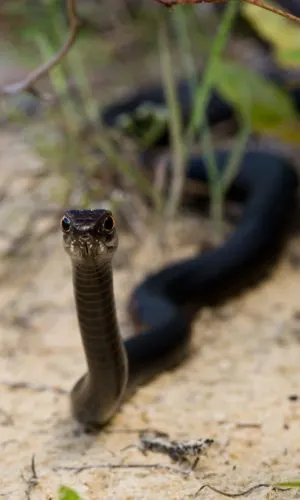
- Experience Level: Intermediate
- Family: Colubridae
- Scientific Name: Coluber constrictor constrictor
- Other Names: Northern Black Racer
- Adult Size: 33 to 65 inches
- Lifespan: 10 years
Although Black Racers are non-venomous, they are sometimes a little bit aggressive when defensive. As long as you don’t startle or corner it, it will not deliberately try to attack you.
They can grow fairly large and will raise their head when threatened before striking.
Black racers do not usually feel threatened by humans but you should still not give it a reason to use self-defense. A bite can still be painful and susceptible to infection regardless of whether or not there is venom.
As far as these snakes go as pets, they are not particularly docile and will only rarely become accustomed to being handled. Black racers also like to travel a lot over long distances, making them unsuitable for a tank or terrarium habitat.
Northern Black Racers have large, long, slender, solid black, round bodies with a white chin and a faded blue underside. They have smooth, matte-looking scales and a head that is almost the same width as their body.
Some black racers may be blue-gray, brown, dark gray, or rust-colored with blotches on their back as well.
You can find these snakes in habitats that are brushy such as grasslands, old fields, rock ledges, ridges, and agricultural fields.
They prey on toads, frogs, small birds, rodents, and smaller snakes. They may also sometimes feed on insects and invertebrates like moth larvae or butterflies.
3. Wandering Garter Snake
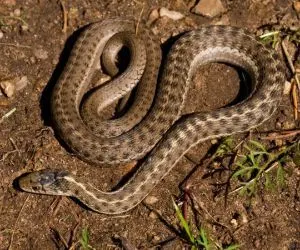
- Experience Level: Beginner
- Family: Colubridae
- Scientific Name: Thamnophis elegans vagrans
- Other Names: Western Terrestrial Garter Snake
- Adult Size: 18 to 43 inches
- Lifespan: 6 to 12 years in captivity; 2 years in the wild
Wandering Garter Snakes are typically gray or gray-brown covered in a black checkered pattern and three cream-colored stripes running down the top and sides of their body.
They prefer to inhabit riparian habitats as well as any other areas with moist climates like lakes, ponds, and wet meadows. You can also find them in sagebrush and coniferous forests.
They will hunt for fish, mollusks, tadpoles, and amphibians in water but will also eat insects like grasshoppers, as well as small vertebrates like birds, reptiles, and mice.
4. Red-sided Garter Snake

- Experience Level: Beginner
- Family: Colubridae
- Scientific Name: Thamnophis sirtalis infernalis
- Other Names: California Red-Sided Garter Snake
- Adult Size: 36 inches
- Lifespan: 10 years
The Red-sided Garter Snake is a subspecies of the common garter snake.
They have a unique look typically checkered red and black on their sides with bright or faded blue stripes running down the middle of their back as well as at each of their sides. In some individuals, this stripe may also be white or green and might also
Typically, this species can be found in California, but they have also been spotted around the east side of Wyoming.
They can be found inhabiting marshes and coastal dunes, but can also strive in a variety of habitats. They are usually found nearby Common Garter Snakes, which like to stick near aquatic habitats.
This species eats a carnivorous diet, feeding on reptiles, amphibians, fish, smaller mammals, insects, earthworms, leeches, and eggs.
They use their mild venom to subdue their prey. It may be an irritant to human flesh as well.
5. Plains Garter Snake
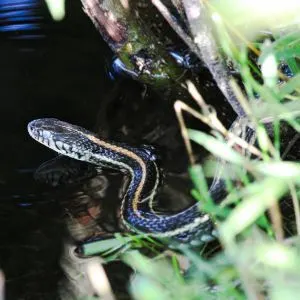
- Experience Level: Beginner
- Family: Colubridae
- Scientific Name: Thamnophis radix
- Adult Size: 16 to 28 inches
- Lifespan: 5 years; sometimes up to 8 years
These non-venomous snakes are friendly by nature, making them a great pet for beginners. They are also relatively small, meaning they aren’t fussy and are easy to care for.
They are black with a distinctive, long yellow or orange stripe running along the whole length of their body. They eat anything they can get their jaws around including amphibians, worms, fish, eggs, and rodents.
They make great garden snakes since they will help you by eating and bugs or other pests.
They enjoy environments that are moist and grassy such as the areas found around streams and lakes.
6. Striped Whipsnake
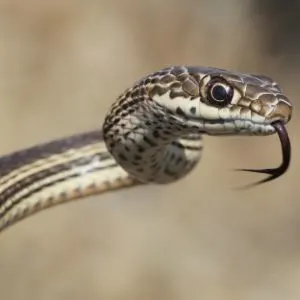
- Experience Level: Expert
- Family: Colubridae
- Scientific Name: Coluber Masticophis taeniatus taeniatus
- Other Names: DesertStriped Whipsnake
- Adult Size: 24 to 67 inches
- Lifespan: anywhere from 10 to 20 years
Desert Striped Whipsnakes are typically black, dark brown, or gray in color with a blue or olive tint to their skin. They have two pale yellow stripes along their backsides all throughout their length.
Their undersides are usually pale yellow or cream from the head fading into a coral red toward the tail.
They can be found in various habitats such as grasslands, canyons, sagebrush flats, shrublands, pine-oak forests, and juniper woodlands. However, they typically prefer rocky streams, mountains, and flatlands.
This species of snake eats smaller mammals, birds, their eggs, amphibians, other snakes including rattlesnakes, and insects.
7. Plains Black-headed Snake
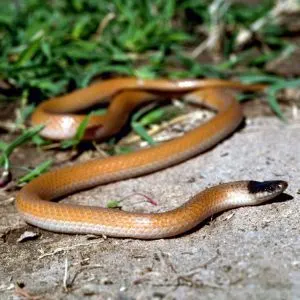
- Experience Level: Intermediate
- Family: Colubridae
- Scientific Name: Tantilla nigriceps
- Other Names: Plains Blackhead Snake
- Adult Size: 7 to 15 inches
- Lifespan: Unknown
Plains Black-headed Snake has a uniform tan to grayish-brown body with a pink-orange underside. Some may have lavender colorations on their neck and chin.
At the top of their head, they have a large black or dark blue that seemingly covers the entirety of their head, which is where they get their name.
You might find them in grassy, rocky prairies, or in hillsides with moist soil. People have even spotted them in their basements.
They mostly eat spiders and beetle larvae, but will also eat centipedes and sometimes scorpions.
8. Bullsnake
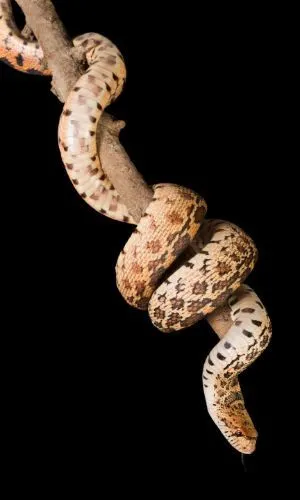
- Experience Level: Intermediate
- Family: Colubridae
- Scientific Name: Pituophis catenifer sayi
- Other Names: Bull Snake
- Adult Size: up to 8 feet
- Lifespan: up to 30 years in captivity; 12 years in the wild
Bullsnakes are a subspecies of the Gophersnake. They can make good pets once accustomed to handling and captivity, which is why you want to look for captive-bred species.
They are large constrictor snakes, though, meaning that they strangle their prey. This species will sometimes do this to more than one animal at a time. You also shouldn’t be too surprised if they try to bite.
Bullsnakes are often mistaken for rattlesnakes due to their similar behaviors. However, they are not as large, have round pupils, narrower heads, don’t have pits over their nostrils, and don’t have rattles on their tails.
These non-venomous snakes are hefty and large with a cream-colored or pale yellow body with brown, black, or copper blotching all throughout. Their heads and necks are almost the same in width as well.
They can be found in open country environments like old fields, native or bluff prairies, pastures, oak savannas, and steep hillsides. They roam sandy-soiled areas where rodents burrow and may also take shelter in agricultural fields, open forests, brush, and any sandy area.
These powerful constrictors live off gophers as well as other small mammals like mice and squirrels. They will also consume amphibians, birds, and their eggs.
9. Eastern Hognose Snake
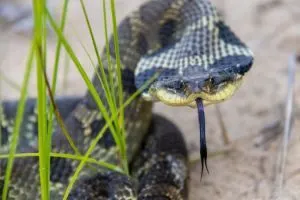
- Experience Level: Beginner
- Family: Colubridae
- Scientific Name: Heterodon platirhinos
- Other Names: Eastern hog-nosed snake
- Adult Size: 20 to 33 inches
- Lifespan: 12 years
The Hognose snake is known to be one of the best pet snakes for enthusiasts since they are not fussy and are comfortable with human interaction. They also stay relatively small.
These worm-like snakes have a large, round head with an upward-facing snout, which is what we all love about them. They are a dark gray or olive-green, but some are also yellow, tan, or light brown with dark brown spotted patterns on their head and sometimes their bodies.
They prefer to inhabit sandy woodlands, farmland, coastal areas, and fields where they feed on frogs, salamanders, invertebrates, birds, and small mammals. They can use their hog-like nose to get into their prey’s burrows more easily.
10. Smooth Green Snake
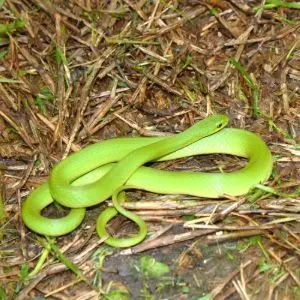
- Experience Level: Intermediate
- Family: Colubridae
- Scientific Name: Opheodrys vernalis
- Other Names: Green Snake
- Adult Size: 14 to 20 inches
- Lifespan: 6 years
While you can find these snakes out in the wilderness, they are rarely encountered due to their timid nature.
Smooth Green snakes can make great pets for any owner that is a little squeamish about feeding them dead rodents. These guys will mostly eat insects like spiders, moths, ants, snails, slugs, worms, and spineless caterpillars.
However, it is said that they do not make great pets since they are way too timid for human interaction. However, they are harmless and some enjoy being handled.
They can be found in open woods, stream edges, marshes, and meadows. They thrive in moist, grassy areas.
As you can already tell by their name, these snakes will be a bright green, which can range in shade. They stay relatively small and may have a pale yellow underside with beady eyes.
These are not the easiest snakes to keep captive since they are very anxious and easily stressed out.
11. Black Hills Red-bellied Snake
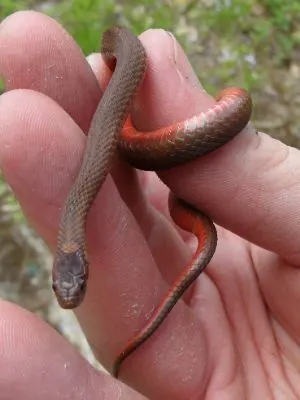
- Experience Level: Intermediate
- Family: Colubridae
- Scientific Name: Storeria occipitomaculata
- Other Names: Redbelly snake, Red-belly Snake, Copperbelly Snake, Northern Red-bellied Snake
- Adult Size: 8 to 16 inches
- Lifespan: 4 years in captivity; Wild lifespan unknown but predicted to be longer than in captivity
While Black Hills Red-bellied Snakes are rarely encountered in the state, they still exist in the wilderness. They are just very secretive.
These small snakes can be found in swarms basking in the sun on the warm days of September to October. You can also find them in woodlands, fields, under logs, in forests, bike trails, back roads, and sphagnum bogs.
In these areas, they feed on earthworms, beetle larvae, and slugs.
People can sometimes find them out in their pesticide-free garden or just out in the wild and might want to keep them as a pet. However, they really struggle to eat when in captivity and will sometimes just outright refuse when they are removed from the wild.
They do not do well in captivity and prefer to be free to roam the lands as they please. Although they aren’t hard to obtain in the wild, they might not be the best pet to keep if you are planning to have it for long since they do not do well away from their natural habitat.
Due to this, you might not run into them as often in the wild since they like to stick to their spaces. They are not as tolerant of populated areas.
It’s not hard to identify these snakes since they really do live up to their name with their flashy red or orange undersides. Their bodies might be a dark steel grey, black with a blue tint, or copper brown. Some may also have two dark stripes along their sides or a thick, light-colored band down the middle of their backs.
While they will usually first curl their tails or flee in defense before they try to bite, their little nibble probably won’t affect you anyway.
While they are small and beautiful, this does not mean they will make a good pet since they do not usually survive long in captivity.
12. Pale Milk Snake

- Experience Level: Beginner
- Family: Colubridae
- Scientific Name: Lampropeltis triangulum multistriata
- Other Names: Milk Snake
- Adult Size: 24 to 36 inches
- Lifespan: up to 20 years in captivity; 15 years in the wild
Milksnakes are a non-venomous, docile, beautiful snake that is great for beginners. They are a species of kingsnake that will vary significantly in color, patterns, and size, depending on the individual snake.
They are generally colorful with a gray or tan body with a V or Y-shaped pattern on their neck. They are usually striped or blotched with black and copper, rusty, red or orange with white, or yellow blotchy striped patterns amongst these colors as well.
They look almost exactly like regular Milksnakes, except these will typically have more of the white, cream, or pale yellow striping or they will be thicker than the other colors, giving them the name “Pale Milksnake”.
Again, these can be significantly different depending on the subspecies, but typically, they will look like they are black, white, and red-orange striped. All milksnakes will have black and light stripes or blotches throughout their length.
While Milksnakes can make a home out of a variety of habitats, they prefer forest edges, prairies, open woodlands, rocky hillsides, near rivers or streams, grasslands, rocky hillsides, rocky mountains, and suburban farmlands.
They do not like to be seen and have a secretive demeanor. This is why they are rarely encountered.
They are carnivorous snakes, feeding on rodents, birds, small reptiles, and their eggs. They may also eat other snakes, even as hatchlings.
13. Northern Rubber Boa
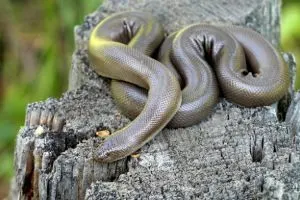
- Experience Level: Beginner
- Family: Boidae
- Scientific Name: Charina bottae
- Other Names: Coastal Rubber Boa
- Adult Size: 14 to 33 inches
- Lifespan: 30 years
These snakes are slow-moving and like sitting around in our warm hands and arms. They are friendly and might actually enjoy being handled.
They get their name from their rubbery skin, which you will notice if you ever hold one. It does feel similar to rubber, but a lot softer.
These snakes come in a tan to grey or brown color tone. Their skin is shiny and their head is quite uniform to the rest of their girth.
They can be found in a range of habitats from coniferous forests to desert lands, but are rarely encountered by humans.
They eat mice and other small mammals, even sometimes feasting on tinier snakes or lizard eggs.
Venomous Snake Species in Wyoming
Here is a list of the most venomous snakes that roam the state:
14. Prairie Rattlesnake
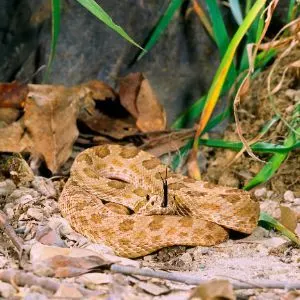
- Experience Level: Expert
- Family: Viperidae
- Scientific Name: Crotalus viridis
- Other Names: Western Rattlesnake, Great Plains Rattlesnake
- Adult Size: 5 feet
- Lifespan: 16 to 20 years in the wild; 24 years max in captivity
If you suffer a bite from this viper and don’t get it treated, it can be very dangerous, and even fatal.
This venomous pit viper is a tan, hefty rattlesnake with dark brown blotches or bands along their backsides, splitting into dark olive or brown rings at their tail.
They can be spotted in sagebrush, grasslands, and high rocky ledges. Prairie Rattlesnakes mostly consume various kinds of rodents like prairie dogs and rabbits.
Since this is one of the most dangerous snakes of the state, it is completely legal to kill if you encounter one.
15. Midget Faded Rattlesnake
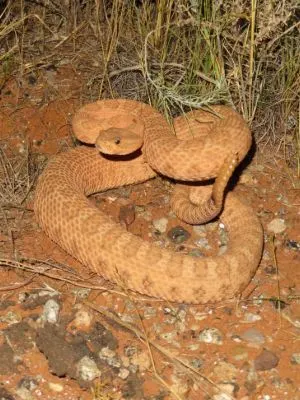
- Experience Level: Expert
- Family: Viperidae
- Scientific Name: Crotalus oreganus concolor
- Other Names: Faded Rattlesnake, Yellow Rattlesnake
- Adult Size: 2 feet
- Lifespan: 15 to 20 years
The Midget Faded Rattlesnake is the smallest member of the western rattlesnake family known for its faded pattern.
They are typically a light tan, pale brown, or pale brown-gray with faded mustard yellow, green, olive, tan, or brown blotches all throughout their body.
They typically live in sagebrush deserts or rock outcrops where they can hunt prey.
While we know little about what they feed on in the wild, they seem to prefer cold-blooded prey such as lizards. We just assume they eat a similar diet to the Prairie Rattlesnake.
This is a protected species in Wyoming, making it illegal to kill, possess, and harass it in any way. However, due to them being venomous, they are killed occasionally.
If you encounter one, alert the Wyoming Game and Fish Department immediately and they will take care of the situation for you.
Conclusion
Now that we’ve been through the snake laws in Wyoming as well as what types of snakes you can find and what you should avoid in the wild, we hope that you have learned something new.
There is not much mentioned about laws in Wyoming when it comes to pet snakes but if you are planning to keep one as a pet, make sure to do your research before going ahead and buying one.
Snakes are a commitment and you want to give them the best life you possibly can.
Let us know below if we missed anything or if there is something about snake laws in Wyoming that you think we should add!
Snakes in other states
